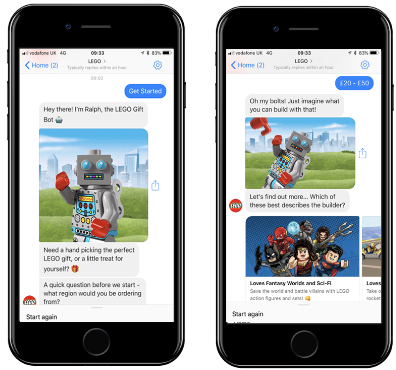How Chatbots Can Improve Your Ecommerce Business

We’ve all seen them, that little box that pops up in the corner of your screen: ‘Hey there! How can I help you?’
You may engage, have your query solved, or you may experience conversational ping-pong with a chatbot that does not provide the answers you need.
As an ecommerce business owner, you may think chatbots are a good, but ultimately unnecessary addition to your website and/ or campaigns. I’m here to tell you you’re wrong.
Chatbots can revolutionise your customer service and give your business a competitive edge. Let's dive into how chatbots can improve your ecommerce business.
According to LivePerson’s analysis of over 20 years of live chat logs, 70% of ecommerce chat inquiries can easily be handled by automation. Think of the cost this could save your business.
Consider these facts:
- 40% of millennials claim that they use chatbots daily
- 64% of internet users say round-the-clock service is the best chatbot attribute
- 67% of millennials say that they are more likely to shop from websites using a chatbot
- 56% of online shoppers say they prefer to resolve issues through messaging apps than to email or call customer service
- 40% of online shoppers say they don’t care whether a chatbot or a person answers their customer service questions (G2)
It’s also evident from Statista’s Global Chatbor Market research that chatbots are on the rise.
So what are chatbots?
Chatbots are computer programs that interact with website users or customers in real time answering questions, recommending products, gathering feedback and tracking engagement (Hootsuite). They provide a cheaper method of answering a wide variety of customer enquiries.
There are three kinds of chatbots:
1. Artificial Intelligence (AI) driven chatbots
AI driven chatbots use natural language processing and conversational AI to mimic human behaviour and speech patterns. Conversational AI works by utilising machine learning to learn natural language conventions over time by itself. The AI learns which phrases are most appropriate to answer the question asked (Hootsuite).
AI chatbots are incredibly useful as they can understand and respond to multiple versions of a similar question such as:
-
“Which cell phone plan would be best for me?”
-
“I need help choosing the right mobile plan.”
-
“Which is your most popular phone plan?”
All of these queries are asking which plan the customer needs. If you suspect your customers will be asking variations of similar questions, AI chatbots will assist your business best.
AI chatbots are usually more expensive and take longer to deploy initially. The idea is, however, that they save money in the long term because they continuously improve as more data is collected, they more deeply understand patterns of behaviour, they make decisions based on prior experience and they understand a variety of different languages (Zoho).
2. Rules-based chatbots
Rules-based chatbots offer answers to predefined questions that a user may ask. They are often simpler chatbots and the most cost-effective initially (Hootsuite). Rule-based chatbots only deliver solutions in accordance to a pre-ordained conversation map and do not learn through subsequent interactions (RingCentral). They therefore fail to answer unexpected or complicated requests. Often rules-based chatbots communicate in a structured, robotic manner. This may cost you in sales and frustrated customers down the track.
Rules-based chatbots can be created using either a codeless chatbot builder or a programmable one. They are also useful in answering and performing simple tasks such as booking appointments. If that suits your business’ requirements, then a rules-based chatbot may be the way to go.
3. Hybrid chatbots
Hybrid chatbots combine both AI and rules-based chatbots in order to serve the straightforward tasks and provide solutions to more complicated questions. Hybrid chatbots are the most useful option for a wide variety of businesses (Freshworks).
What you can’t afford to miss about Ecommerce chatbots
The secret about chatbots is that good chatbots move customers through the buyer's journey. They do this by being an accessible solution to customers’ queries, by nudging customers through a variety of prompts and by providing a wealth of valuable data.
1. How chatbots engage customers
One of the advantages of selling online is being able to sell products at any time. Work 9 to 5 with sport, social and family commitments? No worries; you can order your Christmas presents at midnight if you so desire.
One of the limitations of online stores, however, is that customers’ queries about products can inhibit their purchasing decision. If a customer has a question about your product outside of business hours and no one is available to assist, this can lead them to buy elsewhere or abandon their cart altogether.
Chatbots solve this issue by informing them during their consideration stage, assisting customers through the sales process, and offering suggestions. This can occur in any language and at any time of the day. These factors, alongside chatbots’ quick response time gives the customer a personalised experience, accelerates purchasing decision times, pushes the customer to the next step of the buyer's journey and is more cost-effective for the business.
Another positive feature of chatbots is that they allow multi-channel interactions at scale. You can establish native bots on your website or across multiple channels (omnichannel shopping) such as WhatsApp, Instagram, Facebook Messenger and Google Business Messenger. For more on native vs omnichannel bots, read here.
Chatbots assist your customer relations team by dealing with a large majority of enquiries and handle bot-to-human handoffs when conversations get too complicated for AI.
2. Chatbots assist in subscription and conversion
So it’s clear that chatbots enhance user experience. They can also assist your business in obtaining potential customers’ details and nudging them towards a conversion.
Your chatbot could ask the user for information through the ‘subscribe’ stage of the buyer journey. For example the bot may ask for the user’s email address before assisting them, or it may utilise the user’s cookies in order to further understand your customers’ demographics. (Be sure to consult the appropriate legislation and privacy rules surrounding chatbots in your area).
Chatbots are great at assisting in purchasing decisions. If a customer types ‘I’m looking for a pencil case’ the chatbot can provide a variety of suggestions based on price, best sellers, promoted items, etc. It could also nudge consumers to sales, discount codes, similar products and to the checkout. It is useful to include various calls to action (CTAs) in the conversation, such as ‘shop now’, ‘find my X’ or ‘discover more’. Not only does this provide helpful suggestions to the user, but nudges them closer to a point of purchase or conversion.
3. Chatbots encourage repeat sales
Chatbots should also provide post-sales support about order issues, shipping delays, refunds and returns assist. When chatbots encompass the entire buyer journey well, this encourages repeat business: the ‘ascend’ phase of the customer buyer journey. Similarly, it encourages average lifetime value (LTV) and builds long-term brand loyalty (Hootsuite).
The wealth of data gathered by chatbots provides the tools by which your eCommerce business can understand your audience better and trigger retargeting campaigns. An analysis of the questions asked by your customers informs you about their pain points, behaviour, interactions, goals, needs and interests.
For more ideas on which metrics to track, read here.
The TLDR
Ultimately, a quality chatbot is an essential customer service companion that is cheaper than customer service representatives, more valuable to users due to quick response times, is more valuable to your business by pushing customers further into the customer value journey and, if done well, could assist the overall experience of the consumer, hopefully becoming an advocate or promoter for your business.
Don’t just take our word
HelloFresh
Source: Sumo
Hello Fresh’s Facebook messenger chatbot, Freddy, aimed to cut wait times for customers by automatically responding to numerous customer queries before speaking to a customer service representative. It also acted as a reminder service, provided Spotify playlist suggestions for cooking and the latest news and content from HelloFresh.
- Chatbot Freddy redacted customer wait time by 38% despite a 44% increase in total conversions
- Chatbot Freddy also used a Black Friday promotion that brought in 5x more daily users to the bot than average
- Improved conversion rate by 64%
- Increased message volume by 47%
- Decreased response times by 76% (Sumo)
Nike
Source: Jeff Bullas
Nike undertook a conversational marketing campaign to promote Nike AirMax Day adopting an AI eCommerce Bot, Nike StyleBot, where customers could create custom shoe designs.
- Average click-through rate (CTR) was 12.5x higher than other brand campaigns
- Conversion rate improved 4x above the brand average (Jeff Bullas)
Lego

Source: Sumo
Lego wanted to tackle the problem of choosing the right gift for people with their chatbot, Ralph. Ralph asks a few simple questions such as your location, age of the person you are buying for, gift budget and product theme in order to provide the customer with various suggestions and a link to purchase it. If the user did not engage after that moment, then they will be retargeted within 24 hours through Facebook.
- Chatbot Ralph unlisted Facebook’s click-to-Messenger ads, seeing a 6x return on return on ad spend
- Chatbot Ralph drove 25% of all social media sales and returned a 71% reduction in cost per conversion (Get Talkative)
See more examples here and here.
Chatbot enthusiasts beware
You’re convinced: chatbots can be incredibly useful to both your eCommerce business and your customers. It’s important to understand the limitations of chatbots, however.
1. Know when chatbots end and when human customer service starts
Remember that chatbots are an extension of your customer service team, not a replacement. Chatbots will not be able to answer every query. Ensuring the hand-off from chatbot to human customer service is seamless will be integral to upholding customer satisfaction.
2. While chatbots should be used for automation, they should not be used to handle customer complaints
Despite how clever AI can be, customer complaints need human interaction and understanding.
3. Use chatbots to congratulate customers on milestones but steer clear of anything too personal
Birthdays, customer anniversaries and other general milestones keep customers excited and engaged but beware of anything too personal that you may have gathered from the data.
4. Do not abuse the ability to reach customers through multiple channels
Being able to reach customers in a variety of ways is a blessing but nothing is more ineffective than spam across those channels.
Let’s get started!
There are a variety of ways to implement chatbots on your ecommerce platform, whether it be through native vs. omnichannel bots, whether you create your own bots (see here) or find a company to create it for you.
Ask yourself what service you need the chatbot to perform and adjust this as you gain more information about what your customer needs. Read through comment sections, online reviews and chat rooms. Find the pain points of your business. Use Google Analytics, heat maps and other tools to determine where to deploy your chatbot. Identify the most relevant chatbot metrics for your business including goal completion rate, abandonment rate, conversion steps, handle time, etc (Gartner). Research eCommerce chatbot platforms for your industry to consider which may be most appropriate for you.
Some helpful chatbot providers include: Kik, Chatfuel, Hubspot (previously Motion.ai), ManyChat and Dashbot. Helpful chatbox analytic platforms include: Taplytics, Botanalytics, Meta Analytics Platform and more.
So next time you stumble across a “How can I help you today?” be sure to engage with a pen and paper at hand: it might just give you ideas on how to increase your conversion rates.


